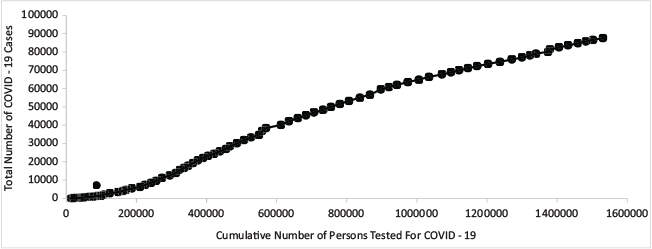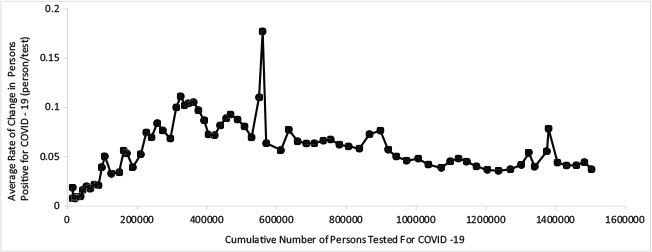
Commentary
Michael Kwok and Thi My Linh Tran
Faculty of Medicine, Warren Alpert Medical School of Brown University, Providence, RI, USA
During the COVID-19 pandemic, most citizens in North America receive daily updates, which highlight the number of new cases per day in a specified region. However, as this data metric is often presented alone on media and news platforms, the spread of the novel coronavirus may often be misinterpreted. Among these daily updates which are critical to informing the public, the authors emphasize the importance of controlling for variation attributed to changes in surveillance. The number of test results that have been analyzed each day along with the total number of tests being conducted in a region have a significant impact on capturing virus spread and should always be included in widespread data. Presenting these variables may help to differentiate increases or decreases of new cases attributed to the expansion of surveillance and testing, or rather other environmental and behavioral factors. Overall, to best inform politicians, healthcare workers, and all citizens of the progress against COVID-19, there is a need to constantly improve analyses and reporting of data.
Keywords: COVID-19, coronavirus, social distance, infections
Owing to the absence of a vaccine, herd immunity, or medication with significant deleterious effects against COVID-19, implementation of social and physical distancing has been followed by many countries to help slow the spread of the virus.1 Through models and past experiences of managing influenza outbreaks, researchers found that household quarantine and case isolation were most effective in mitigating the severity of an epidemic.2 However, social and physical distancing also have real side effects—depression, anxiety, and the overall decline of mental health.3 Therefore, it is necessary that data are accurately disseminated to citizens and decision makers in an effort to make informed choices. Currently, most individuals receive daily COVID-19 updates through social media, televised news outlets, online websites, emails, newspapers, and radios.4 On these platforms, the main message being reported is the number of new cases each day. However, this is problematic. If COVID-19 updates include the number of new cases each day, they should also provide the number of test results that have come back that same day. Including surveillance of the population in reporting can help to adjust for variation in the number of new cases per day solely attributed to variation in testing. For example, hypothetically, if on Day 1 there were 5,000 positive cases out of a total of 100,000 tests, the proportion would be 5%. On Day 2, if there were 6,000 positive cases out of a total of 120,000 tests, the proportion would remain at 5%. However, if a COVID-19 update from a television station, website, newspaper, or radio included only the number of positive cases per day, it would appear that between Days 1 and 2 there were an additional 1,000 positive cases. This may give the impression that COVID-19 has become more contagious. As researchers are advocating to the Canadian government to increase the number of tests done per day, inclusion of surveillance should be paramount to accurately inform citizens.5 Therefore, an example of a graph that reports number of new cases compared to number of tests being conducted may serve as a valid template for any reporting agency or platform.
As Figures 1 and 2 serve as an example or template, all data included were obtained from the database on the official Canadian Government COVID-19 website.6 For the purpose of this paper, the figures are not meant to be analyzed for tracking the progress of COVID-19 in Canada, but rather to illustrate the potential for counties, cities, provinces, or countries to inform citizens on the number of daily COVID-19 cases, while accounting for surveillance variation. As shown in Figure 1, the curve evaluates the proportion of persons who test positive for COVID-19 to the total number of tests conducted in Canada each day. Throughout the pandemic, if there are no subsequent waves, the curve is expected to resemble a sigmoid function, ceteris paribus. At the end of the pandemic, a flattening of the curve, paralleling the x-axis, would be expected, indicating that no new cases of COVID-19 are being reported although the number of tests conducted remains the same or increases. This curve may also inform the reader of the possible rise or drop in COVID-19 positive cases due to increases or decreases in testing and surveillance of the population. This can be compared to other environmental or behavioral factors that may increase viral burden, such as winter in seasonal variation, easing of city lockdowns and social distancing, or mutated viral virulence against population immunity.7 Most likely, increased surveillance and testing would result in a relatively linear increase in the curve, while environmental factors would push the curve upward exponentially.

FIG 1. An Example: Proportion of Persons with a Positive COVID-19 Test to the Cumulative Number of Persons Tested for COVID-19 from March 11, 2020, to May 27, 2020, in Canada.

FIG 2. Derivative Example: Determining the Rate of Change in New Persons Who Test Positive for COVID-19 from March 12, 2020, to May 26, 2020, in Canada.
Furthermore, cities or provinces may also calculate the derivative of this curve, which can help to differentiate between exponential and linear increase, a template shown in Figure 2. The derivative in Figure 2 was calculated by determining the change in number of persons who tested positive for COVID-19 divided by the change in the number of tests conducted in Canada, prior and subsequent to every data point. The significance of finding the derivative is to quantify the rate of change in day-to-day cases, whether it is increasing, decreasing, or remaining constant. For example, the spike at approximately 600,000 tests was correlated to one of the highest increases in daily cases in Ontario, Quebec, and Canada as a whole, relative to the number of tests conducted. These increases were attributed to the increase in cases in nursing and long-term care homes, as well as the peak of community spread in Ontario. Overall, the end of the pandemic or first wave in any region will arrive when the line in Figure 2 approaches 0.
Although Figures 1 and 2 provide a more informed template on disseminating COVID-19 data to the general population, they do have underlying biases and limitations. First, most surveillance and testing in Canada are of symptomatic individuals. As a significant proportion of individuals who test positive for COVID-19 may be asymptomatic,8 data on new cases may not accurately represent overall COVID-19 infections and disease burden in the country. In the future, random testing or sampling of populations may be used to address this limitation. Second, testing access and determining the demographic of individuals to be tested may influence new case numbers. For example, nursing homes and assisted living facilities have a higher risk of outbreak than the overall population.9 Therefore, reporting numbers that predominately include these locations may not accurately represent the entire population. Numbers being reported that involve a per-capita or categorical analysis may be used to ameliorate this limitation. Third, applying Figures 1 and 2 requires extensive collection and access to COVID-19 data. While cities and countries focus on controlling the novel coronavirus in the community, accuracy in data collection and analyses may not be an utmost priority—this may be especially true in places that are overwhelmed by the virus. However, it is imperative to still consistently enforce the value of accurate collection and analysis of COVID-19 data to better direct policymakers.
As regards the daily COVID-19 updates, although the inclusion of number of test results that have been analyzed has limitations, these still remain beneficial for citizens and policymakers to make informed decisions. With the legitimate possibility of subsequent waves of infection and a vaccine being out of immediate reach, it is imperative to constantly further testing methods and analyses. Given that social distancing and compliance to policies are dependent on the sentiment of citizens and how we interpret data and progress, it may be useful to rethink how numbers are portrayed on such powerful disseminating platforms, such as television stations, newspapers, radios, and online websites. Whether the graphs are identically replicated or used as a starting template, this paper advocates for the use of controlling for variation in surveillance when reporting new COVID-19 cases. This perspective can be feasibly achieved and offers realistic benefit.
The authors would like to thank Dr. Anthony Sun and JP Kong for their suggestions.
The authors declare that they have no conflict of interest.
The authors declare no financial support from grants or any external sources of funding.
Data were retrieved from public domain resources.
No ethics approval needed for this commentary.